Es gibt einige nachzutragen: über Ostern lief auf whatifmodelers.com ein "One Week Group Build" (ohne konkretes Thema), und ich war mit zwei Modellen dabei. Hier die Nummer eins, und zwar eine 1:72 Supermarine Spitfire Mk. XVIe Trop (Type 361); aircraft "١٥٤ ﻞ/L 154" of 2nd Squadron, Lebanese Air Force (LAF) (القوات الجوية اللبنانية/Al Quwwat al-Jawwiya al-Lubnaniyya); Rayak Air Base, 1951.

1:72 Supermarine Spitfire Mk. XVIe Trop (Type 361); aircraft "١٥٤ ﻞ/L 154" of 2nd Squadron, Lebanese Air Force (LAF) (القوات الجوية اللبنانية‎/Al Quwwat al-Jawwiya al-Lubnaniyya); Rayak Air Base, 1951 (Whif/Heller kit conversion) by
dizzyfugu, on Flickr

1:72 Supermarine Spitfire Mk. XVIe Trop (Type 361); aircraft "١٥٤ ﻞ/L 154" of 2nd Squadron, Lebanese Air Force (LAF) (القوات الجوية اللبنانية‎/Al Quwwat al-Jawwiya al-Lubnaniyya); Rayak Air Base, 1951 (Whif/Heller kit conversion) by
dizzyfugu, on Flickr
Some background:The Supermarine Spitfire is a British single-seat fighter aircraft that was used by the Royal Air Force and many other Allied countries during and after the Second World War. The Spitfire was built in many variants, using several wing configurations, and was produced in greater numbers than any other British aircraft.
The Spitfire was designed as a short-range, high-performance interceptor aircraft by R. J. Mitchell, chief designer at Supermarine Aviation Works (which operated as a subsidiary of Vickers-Armstrong from 1928). In accordance with its role as an interceptor, Mitchell designed the Spitfire's distinctive elliptical wing to have the thinnest possible cross-section; this thin wing enabled the Spitfire to have a higher top speed than several contemporary fighters, including the Hawker Hurricane.
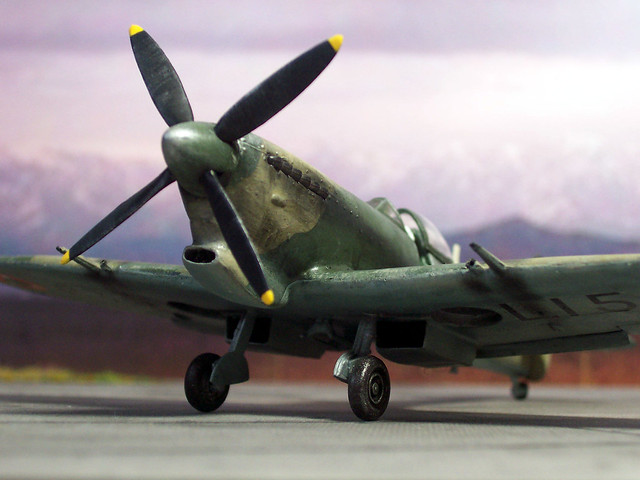 1:72 Supermarine Spitfire Mk. XVIe Trop (Type 361); aircraft "١٥٤ ﻞ/L 154" of 2nd Squadron, Lebanese Air Force (LAF) (القوات الجوية اللبنانية‎/Al Quwwat al-Jawwiya al-Lubnaniyya); Rayak Air Base, 1951 (Whif/Heller kit conversion) by dizzyfugu, on Flickr
1:72 Supermarine Spitfire Mk. XVIe Trop (Type 361); aircraft "١٥٤ ﻞ/L 154" of 2nd Squadron, Lebanese Air Force (LAF) (القوات الجوية اللبنانية‎/Al Quwwat al-Jawwiya al-Lubnaniyya); Rayak Air Base, 1951 (Whif/Heller kit conversion) by dizzyfugu, on Flickr
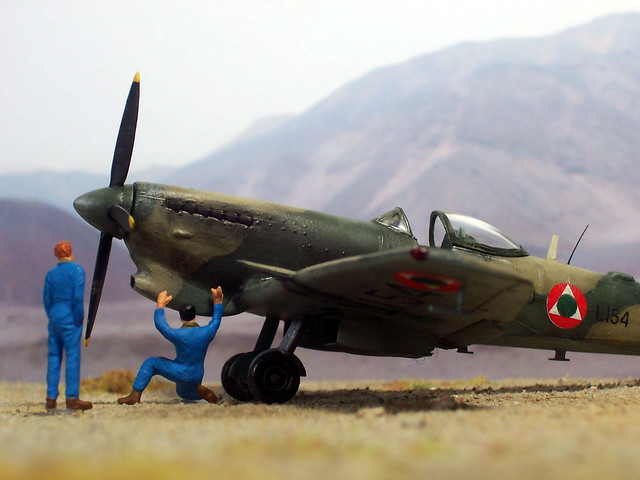 1:72 Supermarine Spitfire Mk. XVIe Trop (Type 361); aircraft "١٥٤ ﻞ/L 154" of 2nd Squadron, Lebanese Air Force (LAF) (القوات الجوية اللبنانية‎/Al Quwwat al-Jawwiya al-Lubnaniyya); Rayak Air Base, 1951 (Whif/Heller kit conversion) by dizzyfugu, on Flickr
1:72 Supermarine Spitfire Mk. XVIe Trop (Type 361); aircraft "١٥٤ ﻞ/L 154" of 2nd Squadron, Lebanese Air Force (LAF) (القوات الجوية اللبنانية‎/Al Quwwat al-Jawwiya al-Lubnaniyya); Rayak Air Base, 1951 (Whif/Heller kit conversion) by dizzyfugu, on Flickr
 1:72 Supermarine Spitfire Mk. XVIe Trop (Type 361); aircraft "١٥٤ ﻞ/L 154" of 2nd Squadron, Lebanese Air Force (LAF) (القوات الجوية اللبنانية‎/Al Quwwat al-Jawwiya al-Lubnaniyya); Rayak Air Base, 1951 (Whif/Heller kit conversion) by dizzyfugu, on Flickr
1:72 Supermarine Spitfire Mk. XVIe Trop (Type 361); aircraft "١٥٤ ﻞ/L 154" of 2nd Squadron, Lebanese Air Force (LAF) (القوات الجوية اللبنانية‎/Al Quwwat al-Jawwiya al-Lubnaniyya); Rayak Air Base, 1951 (Whif/Heller kit conversion) by dizzyfugu, on Flickr
It was the only British fighter to be in continuous production throughout World War II, and remained in service with several air forces around the world for several years. One of its post-war operators was the Lebanese Air Force, or Al Quwwat al-Jawwiya al-Lubnaniyya (لقوات الجوية اللبنانية).
The Lebanese Air Force was established in 1949 under the command of then-Lieutenant Colonel Emile Boustany who later became commander of the army. Soon after its establishment, a number of planes were donated by the British, French, and Italian governments, with additional planes donated by Britain and Italy later that same year.
Britain donated 4 Percival Prentices, 2 World War II-era Percival Proctors and seven trpocailized Supermarine Spitfires (six Mk. XVIe and one TR.8 two-seater), while Italy donated 4 Savoia-Marchetti SM.79 bombers which were mainly used for transportation.
 1:72 Supermarine Spitfire Mk. XVIe Trop (Type 361); aircraft "١٥٤ ﻞ/L 154" of 2nd Squadron, Lebanese Air Force (LAF) (القوات الجوية اللبنانية‎/Al Quwwat al-Jawwiya al-Lubnaniyya); Rayak Air Base, 1951 (Whif/Heller kit conversion) by dizzyfugu, on Flickr
1:72 Supermarine Spitfire Mk. XVIe Trop (Type 361); aircraft "١٥٤ ﻞ/L 154" of 2nd Squadron, Lebanese Air Force (LAF) (القوات الجوية اللبنانية‎/Al Quwwat al-Jawwiya al-Lubnaniyya); Rayak Air Base, 1951 (Whif/Heller kit conversion) by dizzyfugu, on Flickr
 1:72 Supermarine Spitfire Mk. XVIe Trop (Type 361); aircraft "١٥٤ ﻞ/L 154" of 2nd Squadron, Lebanese Air Force (LAF) (القوات الجوية اللبنانية‎/Al Quwwat al-Jawwiya al-Lubnaniyya); Rayak Air Base, 1951 (Whif/Heller kit conversion) by dizzyfugu, on Flickr
1:72 Supermarine Spitfire Mk. XVIe Trop (Type 361); aircraft "١٥٤ ﻞ/L 154" of 2nd Squadron, Lebanese Air Force (LAF) (القوات الجوية اللبنانية‎/Al Quwwat al-Jawwiya al-Lubnaniyya); Rayak Air Base, 1951 (Whif/Heller kit conversion) by dizzyfugu, on Flickr
 1:72 Supermarine Spitfire Mk. XVIe Trop (Type 361); aircraft "١٥٤ ﻞ/L 154" of 2nd Squadron, Lebanese Air Force (LAF) (القوات الجوية اللبنانية‎/Al Quwwat al-Jawwiya al-Lubnaniyya); Rayak Air Base, 1951 (Whif/Heller kit conversion) by dizzyfugu, on Flickr
1:72 Supermarine Spitfire Mk. XVIe Trop (Type 361); aircraft "١٥٤ ﻞ/L 154" of 2nd Squadron, Lebanese Air Force (LAF) (القوات الجوية اللبنانية‎/Al Quwwat al-Jawwiya al-Lubnaniyya); Rayak Air Base, 1951 (Whif/Heller kit conversion) by dizzyfugu, on Flickr
The Mk XVI Spitfire was a WWII design, and the last variant powered by a Merlin engine and based on the original, sleek fuselage. It was basically the same as the Mk IX, except for the engine, a Merlin 266. The Merlin 266 was the Merlin 66 and was built under licence in the USA by the Packard Motor Company. The "2" was added as a prefix in order to avoid confusion with the engines, as they required different tooling.
All Mk XVI aircraft produced (a total of 1,054 Mk XVIs left Castle Bromwich) were of the Low-Altitude Fighter (LF) variety. This was not determined by the length of the wings (clipped wings were fitted to most LF Spitfires), but by the engine, which had been optimised for low-altitude operation. All production Mk XVIs had clipped wings for low altitude work and were fitted with the rear fuselage fuel tanks with a combined capacity of 75 gal. Many XVIs featured cut-down rear fuselages with bubble canopies. On these aircraft the rear fuselage tank capacity was limited to 66 gal.
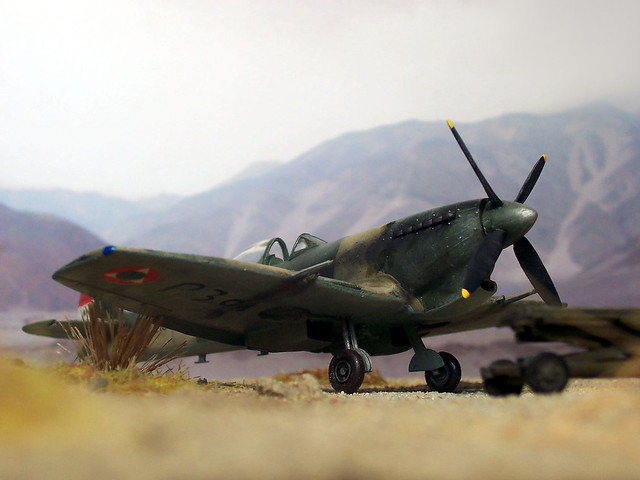 1:72 Supermarine Spitfire Mk. XVIe Trop (Type 361); aircraft "١٥٤ ﻞ/L 154" of 2nd Squadron, Lebanese Air Force (LAF) (القوات الجوية اللبنانية‎/Al Quwwat al-Jawwiya al-Lubnaniyya); Rayak Air Base, 1951 (Whif/Heller kit conversion) by dizzyfugu, on Flickr
1:72 Supermarine Spitfire Mk. XVIe Trop (Type 361); aircraft "١٥٤ ﻞ/L 154" of 2nd Squadron, Lebanese Air Force (LAF) (القوات الجوية اللبنانية‎/Al Quwwat al-Jawwiya al-Lubnaniyya); Rayak Air Base, 1951 (Whif/Heller kit conversion) by dizzyfugu, on Flickr
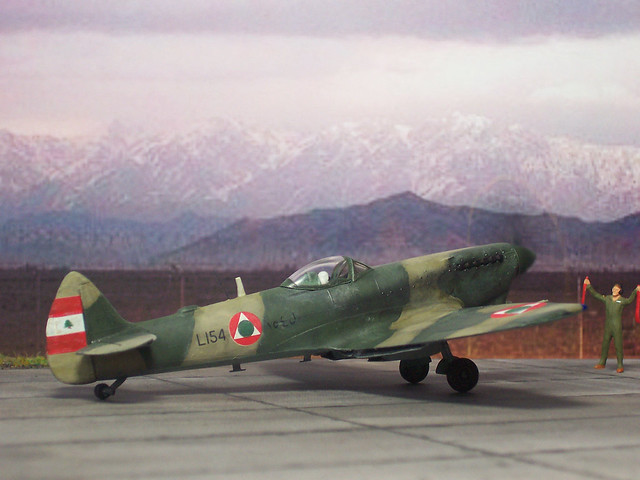 1:72 Supermarine Spitfire Mk. XVIe Trop (Type 361); aircraft "١٥٤ ﻞ/L 154" of 2nd Squadron, Lebanese Air Force (LAF) (القوات الجوية اللبنانية‎/Al Quwwat al-Jawwiya al-Lubnaniyya); Rayak Air Base, 1951 (Whif/Heller kit conversion) by dizzyfugu, on Flickr
1:72 Supermarine Spitfire Mk. XVIe Trop (Type 361); aircraft "١٥٤ ﻞ/L 154" of 2nd Squadron, Lebanese Air Force (LAF) (القوات الجوية اللبنانية‎/Al Quwwat al-Jawwiya al-Lubnaniyya); Rayak Air Base, 1951 (Whif/Heller kit conversion) by dizzyfugu, on Flickr
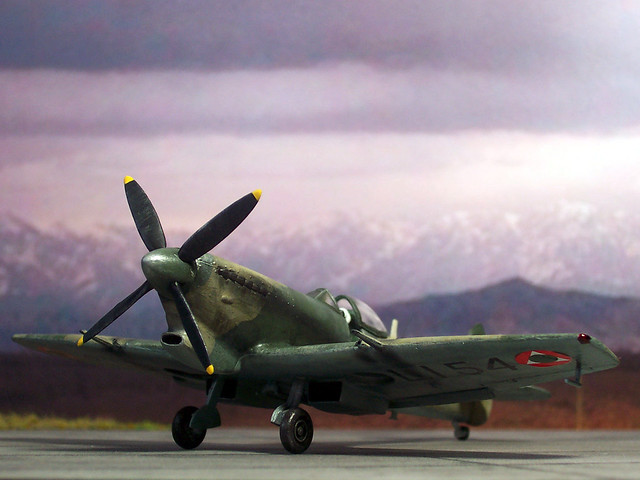 1:72 Supermarine Spitfire Mk. XVIe Trop (Type 361); aircraft "١٥٤ ﻞ/L 154" of 2nd Squadron, Lebanese Air Force (LAF) (القوات الجوية اللبنانية‎/Al Quwwat al-Jawwiya al-Lubnaniyya); Rayak Air Base, 1951 (Whif/Heller kit conversion) by dizzyfugu, on Flickr
1:72 Supermarine Spitfire Mk. XVIe Trop (Type 361); aircraft "١٥٤ ﻞ/L 154" of 2nd Squadron, Lebanese Air Force (LAF) (القوات الجوية اللبنانية‎/Al Quwwat al-Jawwiya al-Lubnaniyya); Rayak Air Base, 1951 (Whif/Heller kit conversion) by dizzyfugu, on Flickr
Because of a slightly taller intercooler and rearranged accessories on the Packard Merlins a new, bulged upper cowling was introduced, a detail that also appeared on late production IXs. For the service in the Middel East region the Lebanese machines received dust filters which considerably changed the aircraft's silhouette.
Armament consisted of two 20 mm Hispano II cannons - each with 120 rpg - and two 0.50 calibre Browning machine guns - each with 250 rpg. 1 × 500 lb (227 kg) bomb could be carried underneath the centre rack, and 1 × 250 lb (114 kg) bomb could be slung under each wing. As a special feature, the wing hardpoints of the Lebanese Spitfires were "wet" so that slipper tanks with 24 gal. each could be carried, compensating for the reduces rear fuselage tank due to the bubble canopy's lowered dorsal spine.
 1:72 Supermarine Spitfire Mk. XVIe Trop (Type 361); aircraft "١٥٤ ﻞ/L 154" of 2nd Squadron, Lebanese Air Force (LAF) (القوات الجوية اللبنانية‎/Al Quwwat al-Jawwiya al-Lubnaniyya); Rayak Air Base, 1951 (Whif/Heller kit conversion) by dizzyfugu, on Flickr
1:72 Supermarine Spitfire Mk. XVIe Trop (Type 361); aircraft "١٥٤ ﻞ/L 154" of 2nd Squadron, Lebanese Air Force (LAF) (القوات الجوية اللبنانية‎/Al Quwwat al-Jawwiya al-Lubnaniyya); Rayak Air Base, 1951 (Whif/Heller kit conversion) by dizzyfugu, on Flickr
 1:72 Supermarine Spitfire Mk. XVIe Trop (Type 361); aircraft "١٥٤ ﻞ/L 154" of 2nd Squadron, Lebanese Air Force (LAF) (القوات الجوية اللبنانية‎/Al Quwwat al-Jawwiya al-Lubnaniyya); Rayak Air Base, 1951 (Whif/Heller kit conversion) by dizzyfugu, on Flickr
1:72 Supermarine Spitfire Mk. XVIe Trop (Type 361); aircraft "١٥٤ ﻞ/L 154" of 2nd Squadron, Lebanese Air Force (LAF) (القوات الجوية اللبنانية‎/Al Quwwat al-Jawwiya al-Lubnaniyya); Rayak Air Base, 1951 (Whif/Heller kit conversion) by dizzyfugu, on Flickr
The Lebanese Spitfires only saw a short service, since in 1953, jet fighters were introduced when 16 de Havilland Vampire jets were received, and the first Hawker Hunters arrived in 1959, which replaced the obsolete Spitfires. This initial Hunter batch was followed by more Hunters through 1977.
In 1968, 12 Mirage IIIELs were delivered from France but were grounded in the late 1970s due to lack of funds. In 2000, the grounded Mirages were sold to Pakistan, and four Hunters were even revived in 2008 and served until 2014.
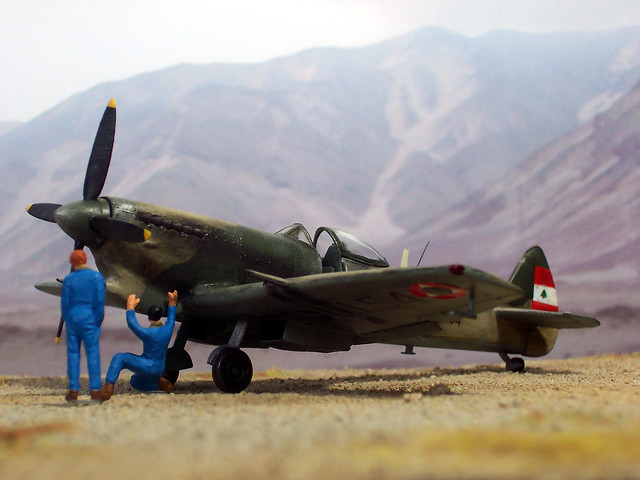 1:72 Supermarine Spitfire Mk. XVIe Trop (Type 361); aircraft "١٥٤ ﻞ/L 154" of 2nd Squadron, Lebanese Air Force (LAF) (القوات الجوية اللبنانية‎/Al Quwwat al-Jawwiya al-Lubnaniyya); Rayak Air Base, 1951 (Whif/Heller kit conversion) by dizzyfugu, on Flickr
1:72 Supermarine Spitfire Mk. XVIe Trop (Type 361); aircraft "١٥٤ ﻞ/L 154" of 2nd Squadron, Lebanese Air Force (LAF) (القوات الجوية اللبنانية‎/Al Quwwat al-Jawwiya al-Lubnaniyya); Rayak Air Base, 1951 (Whif/Heller kit conversion) by dizzyfugu, on Flickr
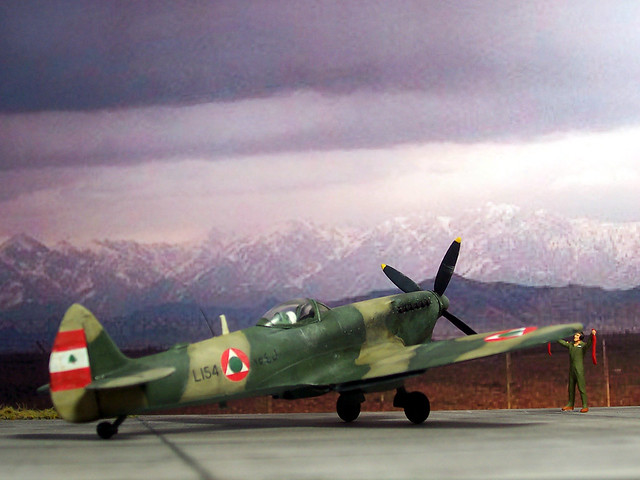 1:72 Supermarine Spitfire Mk. XVIe Trop (Type 361); aircraft "١٥٤ ﻞ/L 154" of 2nd Squadron, Lebanese Air Force (LAF) (القوات الجوية اللبنانية‎/Al Quwwat al-Jawwiya al-Lubnaniyya); Rayak Air Base, 1951 (Whif/Heller kit conversion) by dizzyfugu, on Flickr
1:72 Supermarine Spitfire Mk. XVIe Trop (Type 361); aircraft "١٥٤ ﻞ/L 154" of 2nd Squadron, Lebanese Air Force (LAF) (القوات الجوية اللبنانية‎/Al Quwwat al-Jawwiya al-Lubnaniyya); Rayak Air Base, 1951 (Whif/Heller kit conversion) by dizzyfugu, on Flickr
General characteristics: Crew: one pilot
Length: 29 ft 11 in (9.12 m)
Wingspan: 36 ft 10 in (11.23 m)
Height: 11 ft 5 in (3.86 m)
Wing area: 242.1 ft2 (22.48 m2)
Airfoil: NACA 2209.4(tip)
Empty weight: 5,065 lb (2,297 kg)
Loaded weight: 6,622 lb (3,000 kg)
Max. takeoff weight: 6,700 lb (3,039 kg)
Powerplant: 1× Rolls-Royce Merlin 60 supercharged V12 engine,
rated at 1.470 hp (1.096 kW) at 9.250 ft (2.820 m)
Performance: Maximum speed: 370 mph, (322 kn, 595 km/h)
Combat radius: 410 nmi (470 mi, 760 km)
Ferry range: 991 nmi (1,135 mi, 1,827 km)
Service ceiling: 36,500 ft (11,125 m)
Rate of climb: 2,600 ft/min (13.2 m/s)
Wing loading: 27.35 lb/ft2 (133.5 kg/m²)
Power/mass: 0.22 hp/lb (0.36 kW/kg)
Armament: 2x 20mm Hispano Mk II cannon (120 RPG)
2x .5 in Browning machine guns (250 RPG)
Three hardpoints (1 ventral, 1 under each outer wing) for up to 1.000 lb (454 kg).
War ein echter Quickie, alles in drei(!) Tagen entstanden - dank Vorlauf, so dass alles "Zutaten" im Haus waren. In diesem Falle ist die Basis die Heller-Spitfire Mk. XVI, an der nur wenig verändert wurde; neu sind der Staubfilter (Resinteil) und ein paar Antennen, und der Anstrich ist bewusst nüchtern ausgefallen. Die libanesischen Hoheitszeichen sind improvisiert: es sind gedrehte Österreichische, in die ein grüner Punkt eingesetzt wurde...
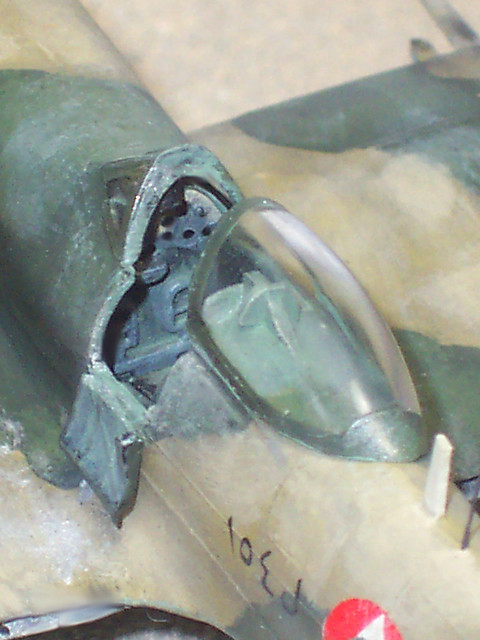
1:72 Supermarine Spitfire Mk. XVIe Trop (Type 361); aircraft "١٥٤ ﻞ/L 154" of 2nd Squadron, Lebanese Air Force (LAF) (القوات الجوية اللبنانية‎/Al Quwwat al-Jawwiya al-Lubnaniyya); Rayak Air Base, 1951 (Whif/Heller kit conversion) by
dizzyfugu, on Flickr

1:72 Supermarine Spitfire Mk. XVIe Trop (Type 361); aircraft "١٥٤ ﻞ/L 154" of 2nd Squadron, Lebanese Air Force (LAF) (القوات الجوية اللبنانية‎/Al Quwwat al-Jawwiya al-Lubnaniyya); Rayak Air Base, 1951 (Whif/Heller kit conversion) by
dizzyfugu, on Flickr
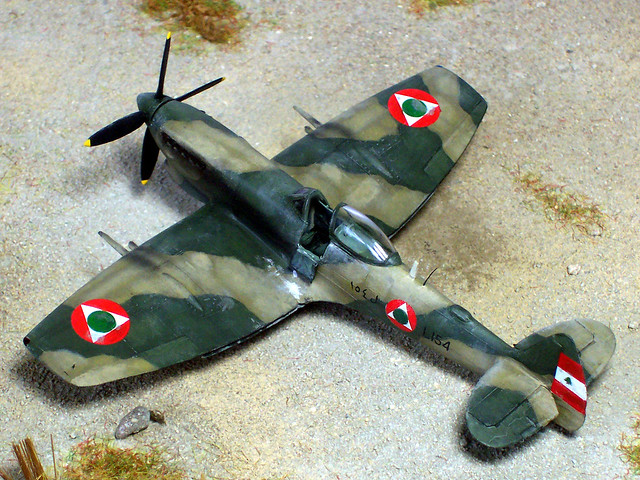
1:72 Supermarine Spitfire Mk. XVIe Trop (Type 361); aircraft "١٥٤ ﻞ/L 154" of 2nd Squadron, Lebanese Air Force (LAF) (القوات الجوية اللبنانية‎/Al Quwwat al-Jawwiya al-Lubnaniyya); Rayak Air Base, 1951 (Whif/Heller kit conversion) by
dizzyfugu, on Flickr

1:72 Supermarine Spitfire Mk. XVIe Trop (Type 361); aircraft "١٥٤ ﻞ/L 154" of 2nd Squadron, Lebanese Air Force (LAF) (القوات الجوية اللبنانية‎/Al Quwwat al-Jawwiya al-Lubnaniyya); Rayak Air Base, 1951 (Whif/Heller kit conversion) by
dizzyfugu, on Flickr

1:72 Supermarine Spitfire Mk. XVIe Trop (Type 361); aircraft "١٥٤ ﻞ/L 154" of 2nd Squadron, Lebanese Air Force (LAF) (القوات الجوية اللبنانية‎/Al Quwwat al-Jawwiya al-Lubnaniyya); Rayak Air Base, 1951 (Whif/Heller kit conversion) by
dizzyfugu, on Flickr